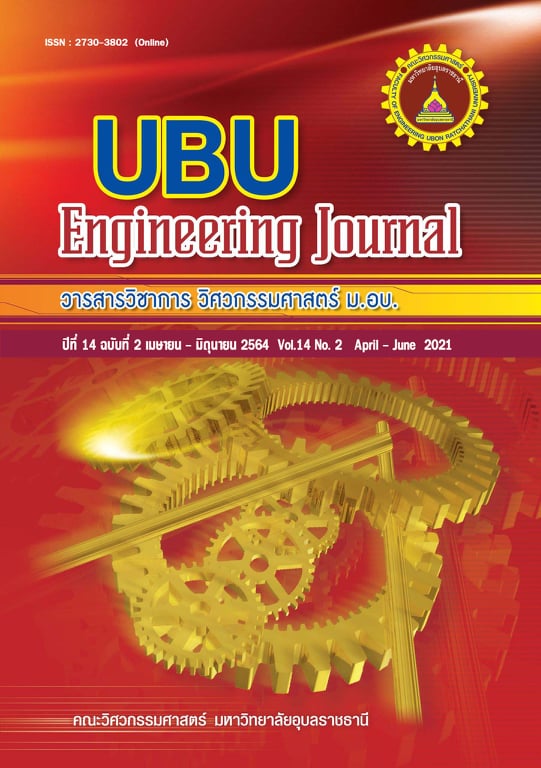Optimization of laccase production from Megasporoporia sp. KKU-LKNG-07 using one factor at a time and response surface methodologies
Main Article Content
Abstract
This study aims to isolate fungi from Lam Khlong Ngu National Park, Kanchanaburi, Thailand and optimize laccase production. The result showed that three fungal isolates could produce laccase including KKU-LKNG-04,KKU-LKNG-07andKKU-LKNG-16. Based on ITS rRNA gene analysis, these fungi (KKU-LKNG-04,KKU-LKNG-07 andKKU-LKNG-16) were similar toGanoderma lucidum, Megasporoporia sp. andRigidopolus vinctus, respectively. The potential fungus isolate which gave the highest lacaase production under solid-state fermentation using sugarcane bagasse as a substate, wasMegasporoporia sp. KKU-LKNG-07.Determination of factors on fungal cultivation related to laccase production was appliedone factor at a time method and optimized by response surface methodology using Box-Behnken approach. The results from one factor at a time method revealed thatconcentration of nitrogen source, pH and temperature obviously influenced fungal cultivation. For optimization of laccase production,the highest laccase production (5.58 U/mL)from fungi Megasporoporia sp. KKU-LKNG-07was predicted under conditions including concentration of nitrogen source, pH and temperature of 4.17 g/L, 8.45 and 29.55 °C, respectively. Later, the laccase production experiment under the optimized conditions was performed. Megasporoporia sp. KKU-LKNG-07 producedlaccase of 5.48 U/mL which was closed to the predicted value.These results indicated the potential of laccase production and optimization which would be useful for further commercial application.
Article Details
References
[2] Khayeng H. Local knowledge of Ethnic Groups on Termite Mushroom Conservation at BRT Research Reports 2007. 2007;444–9.
[3] Nopparat C, Jatupornpipat M, Rittiboon A. Isolation of Phosphate Solubilizing Fungi in Soil From Kanchanaburi , Thailand. KMITL Science and Technology Journal. 2007;7:137–46.
[4] Zheng F, An Q, Meng G, Wu XJ, Dai YC, Si J, et al. A novel laccase from white rot fungus Trametes orientalis: Purification, characterization, and application. International Journal of Biological Macromolecules. 2017;102:758–70.
[5] Kulikova NA, Klein OI, Stepanova E V., Koroleva O V. Use of basidiomycetes in industrial waste processing and utilization technologies: Fundamental and applied aspects (review). Applied Biochemistry and Microbiology. 2011;47(6):565–79.
[6] Baldrian P. Fungal laccases-occurrence and properties. FEMS Microbiology Reviews. 2006;30(2):215–42.
[7] Onsarn A, Ratanapongleka K. Effect of Environmental Conditions and Kinetics of Laccase on Dicofol Removal. Engineering Journal Chiang Mai University. 2019;26(3):12–24.
[8] Yang J, Xu X, Ng TB, Lin J, Ye X. Laccase gene family in Cerrena sp. HYB07: Sequences, heterologous expression and transcriptional analysis. Molecules. 2016;21(8).
[9] Lee H, Jang Y, Choi YS, Kim MJ, Lee J, Lee H, et al. Biotechnological procedures to select white rot fungi for the degradation of PAHs. Journal of Microbiological Methods. 2014;97(1):56–62.
[10] Torres-Duarte C, Roman R, Tinoco R, Vazquez-Duhalt R. Halogenated pesticide transformation by a laccase-mediator system. Chemosphere. 2009;77(5):687–92.
[11] Ratanapongleka K, Phetsom J. Decolorization of Synthetic Dyes by Crude Laccase from Lentinus Polychrous Lev. International Journal of Chemical Engineering. 2014;5(1):26–30.
[12] Senthivelan T, Kanagaraj J, Panda RC. Recent trends in fungal laccase for various industrial applications: An eco-friendly approach - A review. Biotechnology and Bioprocess Engineering. 2016;21(1):19–38.
[13] Viniegra-González G, Favela-Torres E, Aguilar CN, Rómero-Gomez S de J, Díaz-Godínez G, Augur C. Advantages of fungal enzyme production in solid state over liquid fermentation systems. Biochemical Engineering Journal. 2003;13(2–3):157–67.
[14] Jaber SM, Kalsom U, Shah M, Zuriyati A, Asa’ari M, Ariff AB. Optimization of Laccase Production by Locally Isolated Trichoderma muroiana IS1037 Using Rubber Wood Dust as Substrate.BioResources. 2017;12(2):3834–49.
[15] Moller EM, Bahnweg G, Sandermann H, Geiger HH. A simple and efficient protocol for isolation of high molecular weight DNA from filamentous fungi , fruit bodies , and infected plant tissues. Nucleic Acids Research. 1992;20(22):6115–6.
[16] Cázares-García SV, Vázquez-Garcidueñas MS, Vázquez-Marrufo G. Structural and Phylogenetic Analysis of Laccases from Trichoderma: A Bioinformatic Approach. PLoS One. 2013;8(1).
[17] Thongkred P, Lotrakul P, Prasongsuk S, Imai T, Punnapayak H. Oxidation of polycyclic aromatic hydrocarbons by a tropical isolate of Pycnoporus coccineus and its laccase. ScienceAsia. 2011;37(3):225–33.
[18] Anwar Z, Gulfraz M, Irshad M. Agro-industrial lignocellulosic biomass a key to unlock the future bio-energy: A brief review. Journal of Radiation Research and Applied Sciences. 2014;7(2):163–73.
[19] Ferreira FL, Dall’Antonia CB, Shiga EA, Alvim LJ, Pessoni RAB. Sugarcane bagasse as a source of carbon for enzyme production by filamentous fungi. Hoehnea. 2018;45(1):129–33.
[20] Kumar R, Kaur J, Jain S, Kumar A. Optimization of laccase production from Aspergillus flavus by design of experiment technique: Partial purification and characterization. Journal of Genetic Engineering and Biotechnology. 2016;14(1):125–31.
[21] Zhu C, Bao G, Huang S. Optimization of laccase production in the white-rot fungus Pleurotus ostreatus (ACCC 52857) induced through yeast extract and copper. Biotechnology & Biotechnological Equipment. 2016;30(2):270–6.
[22] Bhattacharya SS, Garlapati VK, Banerjee R. Optimization of laccase production using response surface methodology coupled with differential evolution. New Biotechnology. 2011;28(1):31–9.
[23] Nandal P, Ravella SR, Kuhad RC. Laccase production by Coriolopsis caperata RCK2011: Optimization under solid state fermentation by Taguchi DOE methodology. Scientific Reports. 2013;3:1–7.
[24] Senthivelan T, Kanagaraj J, Panda RC, Narayani T. Screening and production of a potential extracellular fungal laccase from Penicillium chrysogenum: Media optimization by response surface methodology (RSM)and central composite rotatable design (CCRD). Biotechnology Reports. 2019;23:e00344.
[25] Levin L, Herrmann C, Papinutti VL. Optimization of lignocellulolytic enzyme production by the white-rot fungus Trametes trogii in solid-state fermentation using res

